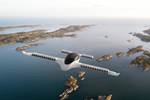Lilium begins eVTOL demonstrator flight testing in Spain
Lilium Jet demonstrator, dubbed Phoenix 2, begins the next phase of flight testing at Spain’s ATLAS Flight Test Center. A third demonstrator will be introduced in summer 2022.

Photo Credit: Lilium
On April 4, Lilium (Munich, Germany), the developer of all-electric vertical takeoff and landing (eVTOL) aircraft, began the next phase of flight testing in Spain with its fifth-generation technology demonstrator for the composite Lilium Jet, dubbed Phoenix 2.
Over the coming months at the ATLAS Flight Test Center located in Jaén, Spain, Lilium plans to extend the flight envelope through full transition and high-speed flight. These developments come after successful flight testing with the same aircraft in southern Germany in 2021.
Lilium also plans to introduce an additional demonstrator aircraft, Phoenix 3, which is scheduled to arrive in Spain for first flight this summer 2022. This aircraft is expected to significantly accelerate the flight test campaign, enabling Lilium to increase learnings and reduce program risks.
According to the company, together with excellent weather conditions, the ATLAS Flight Test Center provides optimal infrastructure and enables aircraft to fly over a large, unpopulated area while transitioning fully to high-speed, wing-borne flight. The modern facilities and support from the Andalusian Foundation for Aerospace Development (FADA) and Center for Advanced Aerospace Technologies (CATEC) have reportedly been instrumental in setting Lilium up for a successful flight test campaign.
“We are excited to have kicked off our next phase of flight testing in Spain,” Daniel Wiegard, co-founder and CEO of Lilium, comments. “This step takes us even closer to reaching our goal of creating a sustainable and accessible mode of high-speed, low-noise regional air mobility.”
Related Content
-
Alef Aeronautics earns FAA approval to launch flying car
FAA certifies testing of California startup Alef’s all-electric composite vehicle, which is drivable on public roads and has VTOL capabilities.
-
Midnight production aircraft completes full transition flight
This is Archer’s second full-scale eVTOL aircraft to achieve this milestone, critical to being able to carry commercially viable passenger payloads.
-
Composites end markets: Automotive (2024)
Recent trends in automotive composites include new materials and developments for battery electric vehicles, hydrogen fuel cell technologies, and recycled and bio-based materials.















